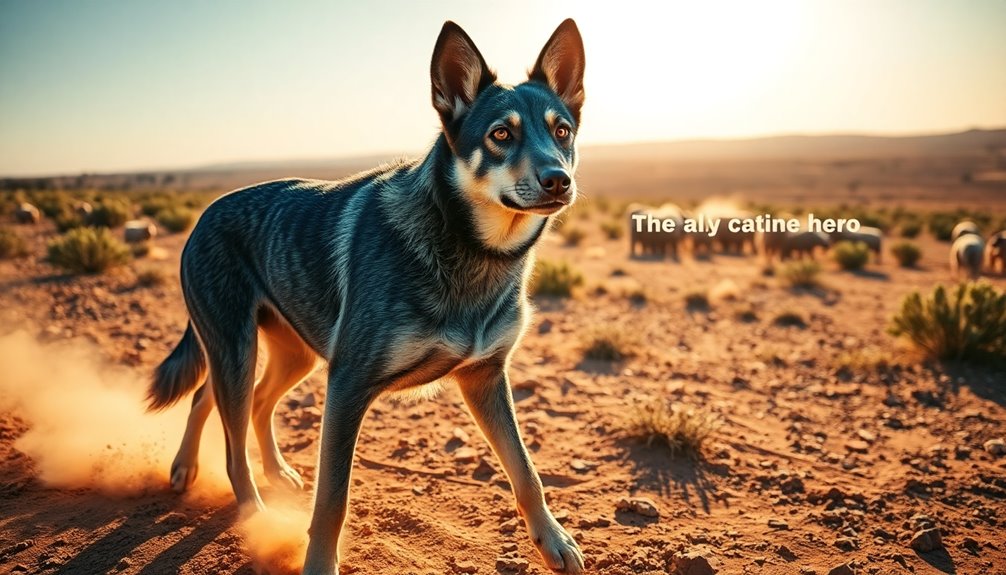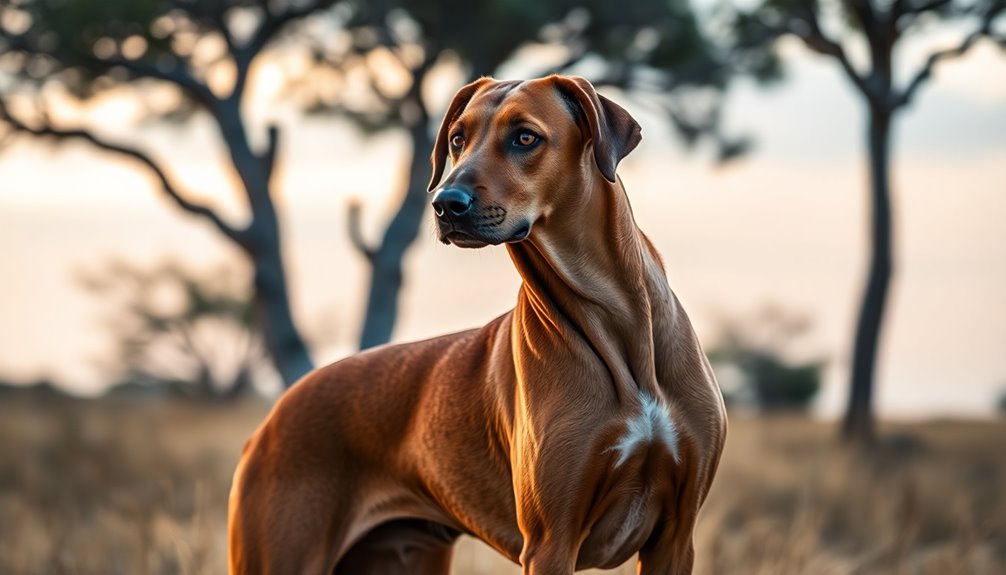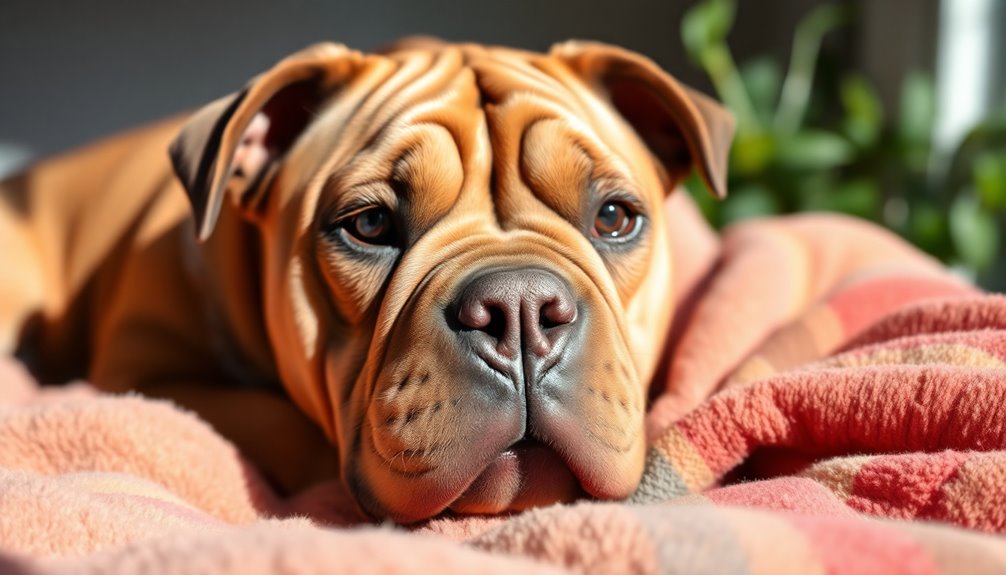Australian Cattle Dogs are truly the hardworking heroes you want by your side. With their impressive intelligence and strong work ethic, they excel in herding and thrive in active environments. These dogs need at least one to two hours of exercise daily, keeping them happy and healthy. Their short double coats come in stunning blue and red mottled patterns, showcasing their unique heritage. Training them is rewarding due to their quick learning ability and eagerness to please. If you're curious about their history, temperament, or how to best care for these remarkable dogs, there's much more to uncover.
Key Takeaways
- Australian Cattle Dogs excel in herding, showcasing their intelligence and strong work ethic developed from their origins in Australia.
- Their high energy levels necessitate at least 1-2 hours of vigorous exercise daily, making them ideal for active households.
- With exceptional problem-solving skills, they learn commands quickly, often grasping new instructions within five repetitions.
- Regular training and socialization are essential to channel their energy positively and prevent behavioral issues.
- Their adaptability and resilience make them reliable companions for various tasks, solidifying their reputation as hardworking canine heroes.
Introduction

Australian Cattle Dogs are a remarkable breed known for their intelligence and energy. With a sturdy, compact build, they typically weigh between 31 to 53 pounds and stand 17 to 20 inches tall. Their short coats come in striking blue, blue-mottled, or red speckled colors, making them visually unique.
As a breed, they're extremely alert and courageous, showcasing loyalty and devotion to their families while remaining wary of strangers. You'll find that they can be playful and affectionate, especially with older children, but they may exhibit herding behaviors, which can lead to aggression with other dogs. This breed is known for its high energy level, requiring dedicated physical and mental engagement to thrive.
To keep this energetic breed happy, you'll need to provide over 40 minutes of exercise daily. They aren't suited for apartment living due to their high energy levels, and boredom can quickly lead to destructive behavior.
Regular brushing is necessary to maintain their coat, which sheds twice a year. Overall, Australian Cattle Dogs thrive in active households, where their intelligence and playful nature can be fully appreciated.
They're not just pets; they're hardworking canine heroes ready to take on any challenge alongside you.
History and Origin

The Australian Cattle Dog originated in the 1800s as immigrants sought a resilient herding companion for their cattle in the harsh Australian landscape. You'll find that early breeders, like Thomas Simpson Hall, experimented with various breeds to create a dog capable of driving livestock over vast distances. This breed was specifically tailored to meet the demands of cattle herding and became essential for ranchers in Australia. The breed's development was influenced by athleticism, durability, and efficiency required for effective cattle management in challenging conditions.
Where and when the breed originated
Originating in the rugged landscapes of Australia, the Australian Cattle Dog was developed to meet the needs of early settlers navigating the challenging conditions of the outback.
This breed emerged primarily in the regions of New South Wales and Queensland during the 19th century, with initial breeding efforts beginning around 1830. Key figures in this development included Thomas Simpson Hall, who significantly contributed from the 1840s to 1870, and the Bagust brothers, who further refined the breed in the 1880s and 1890s.
Early landholders, such as the Halls and ranchers, recognized the need for a robust herding dog capable of managing livestock in unfenced ranges. The breed is known for its high energy levels, which made it particularly effective in herding and managing cattle across vast distances.
The breed was created through a combination of Blue Merle Collies, Smithfields, and even the native Australian Dingo, aiming for traits like resilience and stamina. Other breeds, including Dalmatians and Bull Terriers, were also introduced to enhance specific characteristics.
Cattle Herding and Driving
Developed to handle the unique challenges of cattle herding in the Australian outback, the Australian Cattle Dog's herding and driving capabilities have been honed over generations.
You'll notice their strong drive to control and move livestock, naturally circling and nipping at the heels of the animals. They use a calculated approach, focusing on the specific animals they need to move, whether in larger groups or smaller ones.
Training your Cattle Dog for herding involves basic obedience and advanced techniques. Start with commands like "sit," "stay," and "come," and introduce herding under professional guidance. Highly intelligent dogs like the Australian Cattle Dog excel in learning these commands quickly, which enhances their ability to herd effectively.
As your dog masters these skills, incorporate livestock into training sessions, ensuring they're comfortable around dogs.
Effective herding requires specific commands for driving and gathering livestock, using clear verbal cues and hand signals. Your dog will learn to manage its distance from the herd, responding to commands like "come-bye" or "away."
Communication is key; consistency in your commands will help your dog understand and follow your lead, making it an effective partner in the field.
With practice, your Australian Cattle Dog will thrive in its herding role.
Physical Characteristics
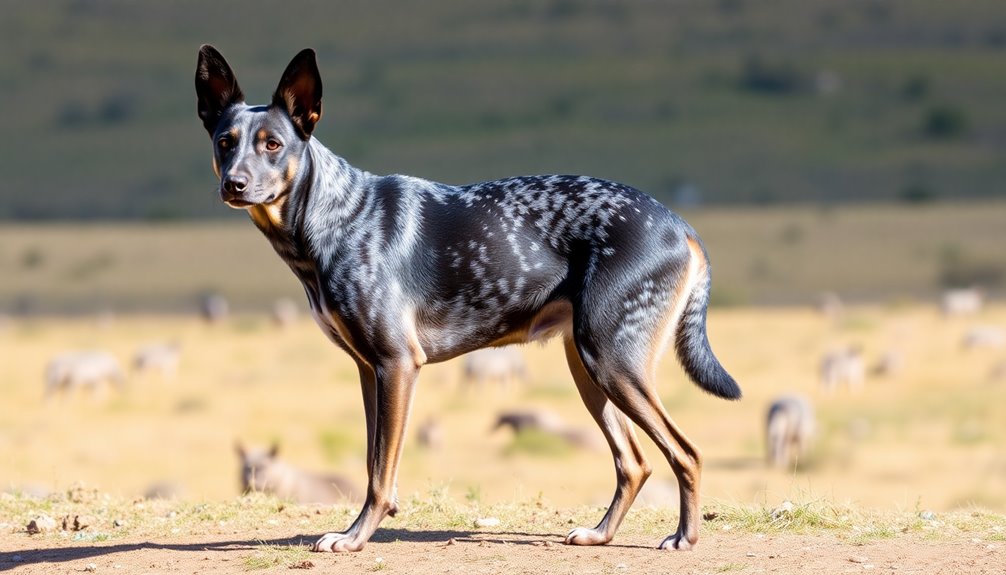
When you look at Australian Cattle Dogs, you'll notice their sturdy, muscular build and medium-length, deep muzzles. Their coats come in striking blue or red speckle, making them stand out in any setting. With a compact size, these dogs typically weigh between 31 and 35 pounds, adapting well to various terrains. Their strong work ethic contributes to their adaptability in different environments, making them ideal companions for active households.
Size, weight, and coat details
What makes Australian Cattle Dogs stand out in terms of physical characteristics? These dogs have a robust, athletic build that's both functional and appealing. Males typically stand between 18 to 20 inches, while females range from 17 to 19 inches tall at the withers. Their bodies are longer than they're tall, maintaining a 10:9 ratio of length to height. Weights vary, with males averaging 33 to 45 pounds and females slightly less, from 31 to 45 pounds.
Their short double coat consists of a protective outer layer and a dense undercoat, requiring moderate grooming. You'll notice they shed once or twice a year, so regular brushing helps manage that. In addition, their short double coat is easily maintainable, which adds to their appeal for potential owners.
Their broad skull and powerful muzzle give them a strong presence, while their upright ears and oval, dark eyes convey alertness. Strong and muscular necks and shoulders support their active lifestyle, and their straight forelegs lead to round, arched feet with sturdy toes.
Mottled Blue and Red Coats
Among the striking features of Australian Cattle Dogs are their unique mottled blue and red coats, which set them apart visually.
The mottled blue coat showcases irregular splotches of blue on a white background, creating a dynamic look. You'll notice that the patches vary in size and shape, often featuring a marbled effect. Permissible markings like black, blue, or tan on the head add to their charm. This coat type is particularly popular among Australian Cattle Dog enthusiasts due to its visually striking and dynamic appearance.
In contrast, the blue speckled coat presents fine blue specks evenly distributed across a white backdrop. This pattern provides a more uniform appearance, as the speckles cover the entire body and measure up to about one inch in size.
When it comes to red coats, the term "mottled" isn't standard; you'll typically see red speckled instead. This beautiful coat results from the intermingling of white and red hairs, with darker red markings found on the head.
Red speckled dogs boast an even distribution of color, making them eye-catching companions. As pups grow, they develop their vibrant red speckle pattern from an initial white coat, showcasing their stunning transformation.
Temperament and Personality
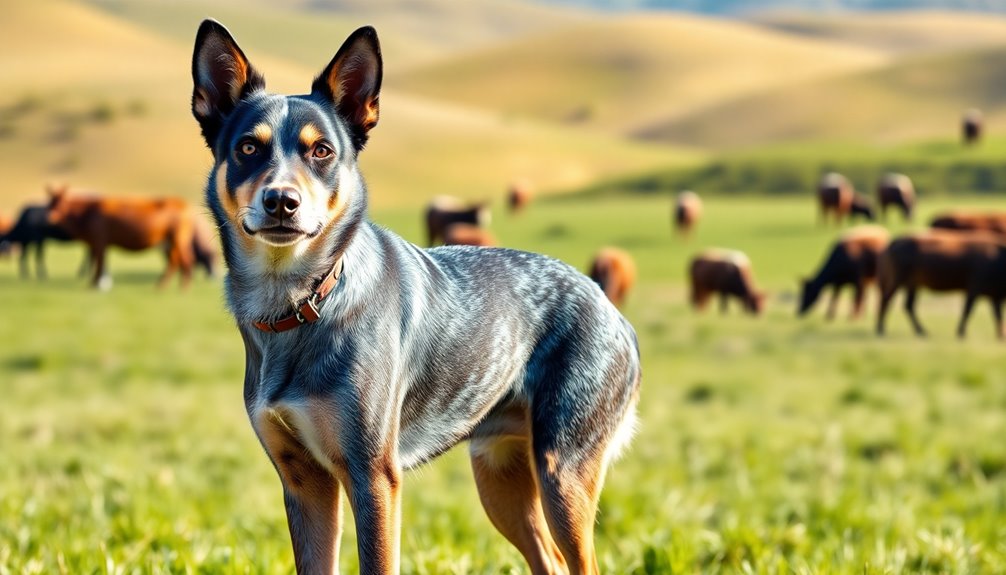
Australian Cattle Dogs are known for their high intelligence and alertness, making them excellent companions for active families and individuals. They excel in herding and agility, which highlights their versatility and energy levels. They thrive in environments where they can engage with their owners and other pets, forming strong bonds along the way. If you're looking for a loyal and energetic dog, this breed could be a perfect fit for your lifestyle.
Highly Intelligent and Alert
Intelligence and alertness define the temperament of the Australian Cattle Dog, making them exceptional companions and working partners.
You'll find that these dogs possess sharp problem-solving skills, allowing them to navigate challenges and devise effective solutions. Their herding background hones their ability to think critically and make quick decisions, whether guiding cattle or encountering everyday obstacles.
You'll appreciate how quickly they learn; Australian Cattle Dogs grasp new commands in fewer than five repetitions and show a remarkable obedience rate of about 85%. Their eagerness to work and please you enhances their learning capacity, showcasing their "Blue Heeler Brainpower." This impressive level of intelligence also allows them to anticipate movements of cattle, further highlighting their herding capabilities. Additionally, their capacity for financial planning ensures that they can adapt to various roles beyond herding.
Adaptability is another hallmark of their personality. These dogs adjust smoothly to new environments and changes in routine, whether in a rural setting or a suburban home. They also pick up on social cues, making them versatile in various situations.
Their keen senses contribute to their alertness, making them exceptional watchdogs. You'll notice how responsive they're to sounds and movements, using their awareness to gauge their surroundings effectively.
This combination of intelligence and alertness makes Australian Cattle Dogs truly remarkable companions.
Suitability for families, individuals, or other pets
When considering a dog for your family or lifestyle, you'll find that Australian Cattle Dogs can be a fantastic fit for active households. Their loyalty and protective nature make them great companions for children, especially if they're raised together. However, their herding instincts may lead them to try and herd younger kids, so supervision and proper training are essential.
These high-energy dogs require significant physical and mental stimulation. Regular exercise, like fetch or agility training, keeps them happy and well-behaved. Additionally, a healthy diet can significantly impact their overall health and energy levels. Maintaining an emotionally aligned environment can also enhance the bond between the dog and family members, fostering positive interactions.
A large fenced yard is necessary to accommodate their needs; otherwise, they can become restless or destructive.
Training and socialization are crucial, particularly in homes with children. Early exposure to various people and environments helps shape their temperament. Consistency and positive reinforcement work wonders, and involving your kids in training can strengthen their bond.
While they can thrive in family settings, Australian Cattle Dogs may not be the best choice for families with very small children due to their high energy and herding instincts. They're better suited for older kids who can respect their needs and interact safely.
With the right environment, they can become wonderful family companions.
Health and Lifespan
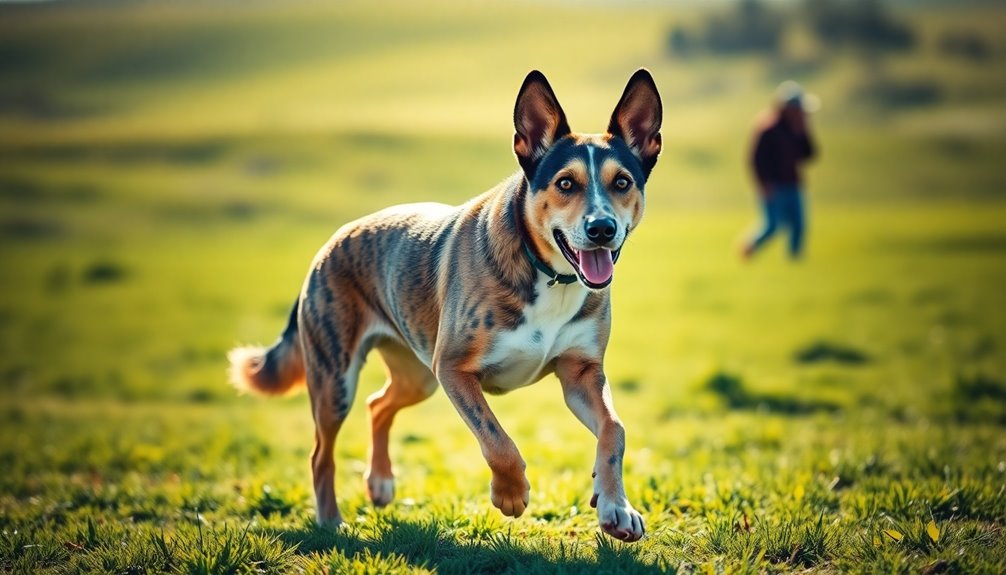
When it comes to the health and lifespan of your Australian Cattle Dog, you'll find they generally live between 12 to 15 years, with some reaching even 18. However, be aware of common health concerns like hip dysplasia and progressive retinal atrophy that can affect them. Additionally, their average lifespan often exceeds many other breeds, making them a resilient choice for dog owners.
Typical lifespan of the breed
Typically, Australian Cattle Dogs enjoy a lifespan ranging from 12 to 16 years, with an average life expectancy of around 14 years, according to a recent study in the UK. With proper care, some individuals can even live up to 16 years or longer. This breed is known for its longevity, with records showing exceptional cases where dogs have lived beyond the average lifespan.
Several factors influence their longevity. Genetics play a significant role, as these dogs come from a tough genetic stock originating in the Australian Outback. A balanced diet rich in high-quality proteins and essential nutrients is crucial for maintaining health. Additionally, substantial daily physical activity and mental stimulation help keep them fit and engaged. Creating a stimulating environment and providing love and attention also contribute to their overall well-being.
Interestingly, the oldest recorded Australian Cattle Dog, named Bluey, lived to be 29 years and five months, with other reports of dogs reaching 32 years. These remarkable cases underscore the breed's potential for an extended lifespan, especially when given the right care and environment. Moreover, regular veterinary check-ups can further enhance their chances of living a long and healthy life.
Common health concerns or genetic predispositions
Australian Cattle Dogs, while known for their resilience and longevity, can face several common health concerns and genetic predispositions that potential owners should be aware of.
One significant issue is Multidrug Resistance, linked to a defect in the MDR1 gene. This condition affects how your dog processes certain medications, so early DNA testing can help identify at-risk dogs.
You should also be aware of Pelger-Huet Anomaly, a rare blood disorder that can be fatal in puppies inheriting the gene from both parents.
Neuronal Ceroid Lipofuscinosis (NCL) is another concern, manifesting as progressive neurologic decline in younger dogs between 1-3 years, with no effective treatment available.
Von Willebrand Disease, a hereditary bleeding disorder, can complicate even minor injuries, requiring careful management. Additionally, regular veterinary check-ups are essential for preventive care.
Furthermore, orthopedic issues like hip dysplasia are common, leading to pain and arthritis as your dog ages. Regular check-ups are crucial for spotting musculoskeletal problems early.
Lastly, Australian Cattle Dogs are prone to bladder and kidney stones, so keep an eye out for symptoms like blood in urine, which necessitates immediate veterinary attention.
Tips for maintaining health and wellness
Maintaining the health and wellness of your Australian Cattle Dog is crucial for ensuring a long, vibrant life. Start with a high-quality diet formulated for active dogs; follow the feeding recommendations on the package and monitor your dog's weight, adjusting portions as needed.
It's best to divide their daily rations into at least two meals, preferably three, and always provide fresh water.
Regular health maintenance is equally important. Schedule routine checkups with your veterinarian to keep vaccinations and parasite checks up to date. These visits help catch any health problems early, including dental issues that can lead to more significant health concerns if left untreated.
Don't forget to evaluate your dog's teeth for potential professional cleaning and maintain a regimen for flea, tick, and heartworm prevention.
Exercise is vital for your Cattle Dog's well-being. Aim for at least an hour or two of vigorous activity daily, engaging in running, hiking, or interactive games. Incorporating daily long walks can significantly enhance your dog's physical health and behavior.
Consider dog sports like agility or obedience for added stimulation.
Lastly, grooming plays a key role in health. Brush your dog's coat weekly, bathe as needed, and keep up with nail trimming and ear cleaning.
Regular dental care is essential, too. These practices help ensure your dog stays happy and healthy for years to come.
Care Requirements

Taking care of your Australian Cattle Dog means meeting their exercise needs, grooming them regularly, and providing a balanced diet.
You'll need to commit to at least 1 to 2 hours of activity each day while also keeping up with brushing to manage their coat. Daily exercise is essential to prevent destructive behavior and keep them mentally stimulated.
Additionally, ensure you're feeding them high-quality food and consulting your vet about their specific dietary needs.
Regular Brushing Required
Regular brushing is essential for keeping your Australian Cattle Dog's coat healthy and vibrant. You should aim to brush your dog at least once a week to maintain its coat quality. During seasonal shedding in spring and fall, increase brushing to 2-3 times a week to manage the extra fur.
Regular brushing removes loose hair, reduces shedding, and prevents matting, which is crucial for your dog's overall grooming. Additionally, being aware of their shedding cycles can help you plan your grooming schedule effectively.
For the best results, use a bristle brush or grooming mitt. A slicker brush or shedding tool can help reach through the topcoat to remove loose undercoat fur. Always brush in the direction of hair growth to avoid irritating your dog's sensitive skin, applying gentle but firm strokes.
Focus on areas prone to matting, such as the neck, back, and tail. By brushing the entire body, you'll help distribute natural oils, keeping the coat healthy and waterproof.
Exercise requirements and energy levels
Australian Cattle Dogs thrive on activity and require a substantial amount of exercise to stay healthy and happy. You should aim for over two hours of exercise each day, including at least an hour or two of vigorous activities. To meet their needs effectively, consider multiple sessions, like morning jogs and afternoon fetch games. Daily walks are essential, but you'll want to supplement them with more engaging activities.
These energetic dogs excel in various exercises such as jogging, hiking, and interactive games. They love participating in dog sports like agility and herding trials. Long fetch sessions, treasure hunts, and mini obstacle courses can effectively expend their energy. Biking and long retrieves are also great options to keep them active.
Additionally, don't forget that mental stimulation is crucial. Activities like puzzle toys, obedience training, and learning new tricks help prevent boredom and frustration. Mixing up activities keeps things interesting, preventing destructive behaviors like chewing and digging. Regular activity is essential for preventing behavioral issues related to boredom.
Feeding tips and diet recommendations
When it comes to feeding your Cattle Dog, providing a balanced diet tailored to their specific needs is crucial for their overall health and well-being.
Focus on high-quality protein sources, such as chicken, beef, lamb, and fish, as these are essential for muscle maintenance. Incorporate healthy fats like fish oil to support their coat and provide energy. Additionally, be mindful of nutritional needs specific to their age and activity level, as this can impact their overall well-being.
Aim for moderate carbohydrate intake from complex sources like whole grains, vegetables, and fruits, which aid digestion and provide sustained energy. Ensure the food is AAFCO-approved to meet necessary nutritional standards.
For adults, feed about 1.5 to 2.5 cups of dry food daily, split into two meals. Puppies need more frequent meals—3 to 4 times a day—adjusting portions based on their age and weight.
Consider any special dietary needs, such as grain allergies or preferences for raw diets, but always consult your veterinarian.
Monitor your dog's weight and health regularly and adjust their diet as needed, especially during different life stages or activity levels. Watch for signs of dietary issues, ensuring your Cattle Dog remains healthy and active.
Training and Socialization

When training your Australian Cattle Dog, consistency is key; these dogs are highly trainable when you stick to clear commands and routines. Gradually exposing them to new environments helps build their confidence and adaptability. Keep in mind that without proper socialization, they may develop separation anxiety and other behavioral issues. Additionally, incorporating positive reinforcement techniques can significantly enhance their learning experience and strengthen your bond.
Highly Trainable With Consistency
To ensure your Australian Cattle Dog thrives, consistency in training is crucial. Clear and uniform guidelines help prevent confusion and behavioral issues.
It's important that all family members enforce the same rules, as this fosters trust and a sense of security for your dog. When everyone is on the same page, you'll create a harmonious and respectful relationship.
Australian Cattle Dogs respond exceptionally well to positive reinforcement. Use treats, praise, and play to encourage desired behaviors.
High-value rewards, like tasty treats or their favorite toys, serve as effective incentives, strengthening behaviors and promoting repetition. This approach builds trust and confidence in your dog, making training a rewarding experience for both of you.
Start training and socialization early, ideally between 3 and 14 weeks of age. Early interactions help establish good habits and reinforce desired behaviors. Additionally, providing vigorous exercise alongside training sessions will help to channel your dog's energy positively.
Introduce your puppy to various people and well-behaved dogs in controlled settings. Gradually increase distractions in training environments as your dog becomes more proficient.
Gradual Exposure to New Environments
Building on the foundation of consistent training, gradually exposing your Australian Cattle Dog to new environments is vital for their development. Start this process early, ideally between 3 and 14 weeks of age.
Begin with low-intensity exposures, like exploring different rooms in your home, and slowly increase the complexity of these environments.
Use positive reinforcement techniques—treats, praise, and play—to create positive associations with new experiences. Ensure that each new setting is safe and non-threatening to prevent any negative experiences. Early socialization during this time is crucial for fostering a well-rounded temperament.
Monitor your dog's body language for signs of stress or discomfort, and adjust the exposure accordingly.
Introduce new stimuli at a pace your dog can handle, rewarding calm interactions with people, dogs, and environments. Pair any previously feared stimuli with positive experiences, using familiar objects like toys or blankets for comfort.
Gradually increase the duration and intensity of exposure sessions, employing desensitization techniques to reduce any fear.
Maintaining a consistent routine, especially with feeding and exercise, will also help your dog adjust. Plan activities to keep them well-exercised, ensuring they remain balanced and relaxed in new settings.
Separation Anxiety in Dogs
Separation anxiety is a common issue that many dog owners face, particularly with breeds like the Australian Cattle Dog. This condition arises when dogs experience extreme distress when left alone, showing symptoms like vocalization, destruction, and restlessness. Triggers can include traumatic separations or simply changes in routine.
To help your dog cope, establishing a predictable daily routine is crucial. Schedule times for attention and ensure your dog has plenty of environmental enrichment, such as toys and treats. Create a safe space, like a crate, where your dog feels comfortable when you're away. Additionally, monitoring behavior with a doggy camera can provide insight into your dog's stress levels while alone.
Training and desensitization are key. Start by leaving your dog alone for short periods, gradually increasing the time apart. Use counterconditioning by associating your departures with positive experiences, like puzzle toys. Reinforce calm behavior by rewarding your dog when they relax, and be consistent with your training.
Additionally, make sure your dog gets enough physical and mental exercise to reduce anxiety. If needed, consider professional help or short-term medication as you work on these strategies.
Ideal Living Environment
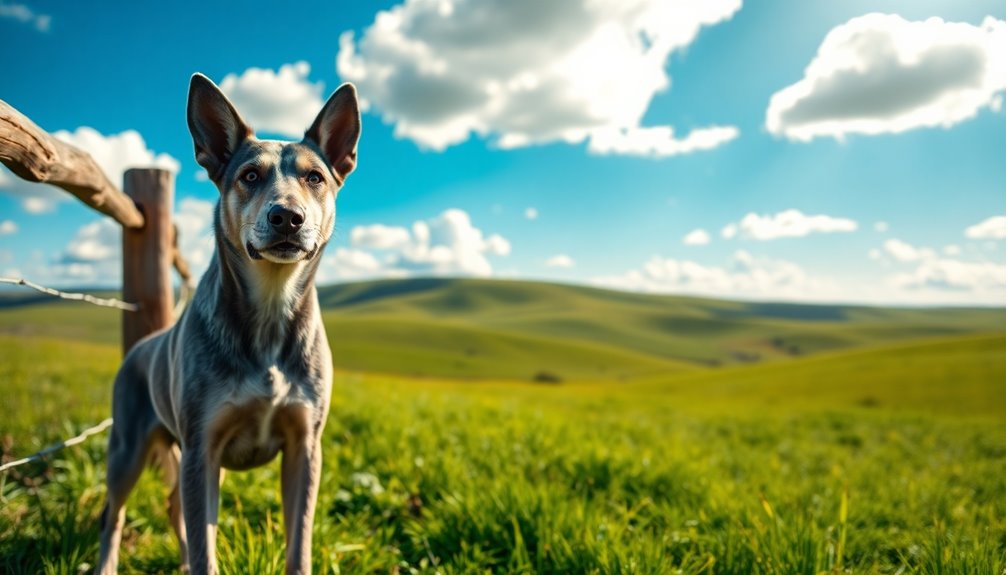
To keep your Australian Cattle Dog happy and healthy, you'll need a spacious backyard where they can run and play. They thrive in various climates, so don't worry if it's hot; just make sure they've access to shade and water. With plenty of room for exercise and sun exposure, your dog will live a fulfilled life. Additionally, they require over 2 hours of physical activity daily, making an active environment essential for their well-being.
Spacious Backyard for Exercise
A spacious backyard is essential for Australian Cattle Dogs, as they thrive on having ample room to run, play, and explore. These energetic dogs require a large, securely fenced yard to accommodate their high-energy activities like running, fetch, and interactive games.
A well-fenced area is crucial for their safety, preventing them from escaping or getting into danger during exercise. Without a large yard, you may notice behavioral issues due to a lack of physical and mental stimulation. Regular exercise is vital for maintaining their muscle tone and preventing obesity, ensuring they remain happy and healthy.
Australian Cattle Dogs aren't suited for apartment living; they need an environment that allows them to engage in active work or play. Homes with expansive backyards are ideal for meeting their needs, especially for families with active lifestyles.
If you don't have a large yard, consider alternative outdoor spaces such as dog parks or hiking trails to ensure your dog gets the exercise they deserve. Regardless of the space, aim for at least 1 to 2 hours of vigorous exercise daily, adjusting activities based on available space.
Heat Tolerance and Sun Exposure
When it comes to heat tolerance and sun exposure, Australian Cattle Dogs are impressively built for warm climates. With their short double coat, they can regulate body temperature effectively, protecting them from both heat and cold.
Originally bred for the harsh Australian landscape, they've developed endurance that allows them to adapt to various climates. However, you still need to provide constant access to fresh, clean water to combat their limited risk of dehydration. Their higher tolerance for dehydration compared to other breeds means they can withstand longer periods without water, but it's still crucial to monitor their hydration levels.
During peak heat hours, usually between 10 a.m. and 4 p.m., limit outdoor activities to prevent heat-related issues. Always keep an eye on surfaces; walking them on hot asphalt or sand can lead to burned paw pads.
Providing shaded areas and well-ventilated spaces is essential for their comfort. Be mindful of sunburn, especially on light-pigmented areas like the nose and ears. Applying dog-specific sunscreen can help mitigate this risk.
Consider using cooling accessories, like vests or mats, to help regulate their temperature. Lastly, always monitor for signs of overheating, and act quickly if you notice excessive panting or lethargy. Your attentiveness ensures a happy, healthy life for your Australian Cattle Dog.
Unique Blue Heeler Heritage
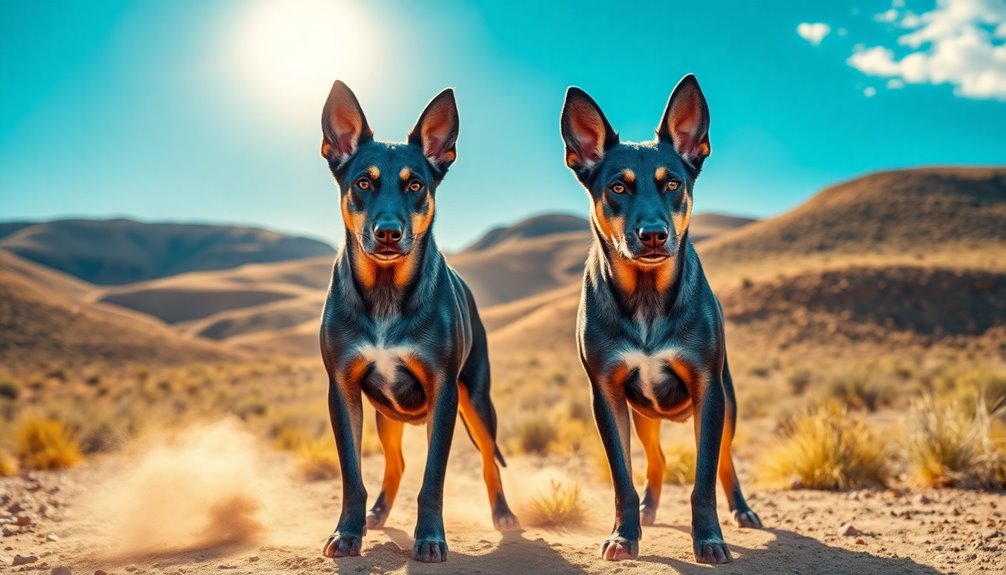
The unique heritage of the Blue Heeler is fascinating, blending diverse ancestry that includes the native Australian dingo. You might be surprised to know that this breed also inspired the iconic cartoon dog, Bluey, capturing hearts around the world. Understanding these roots enriches your appreciation for the breed's incredible traits and history. The Australian Cattle Dog is known for its intelligent and energetic nature, making it an excellent companion for active families.
Diverse Ancestry Includes Dingo Lineage
Though many dog breeds share diverse ancestries, few can claim a lineage as unique as that of the Australian Cattle Dog, which includes a significant contribution from dingoes. Developed in the 1800s by British immigrants, these dogs were initially crossed with blue-speckled Highland Collies to create what was known as Halls Heelers. This breeding aimed to produce a silent, highly adaptable working dog capable of handling large herds of cattle in Australia's harsh conditions.
The dingo's influence played a crucial role in shaping the Australian Cattle Dog's characteristics. By enhancing stamina and promoting silent herding techniques, the dingo lineage contributed to the breed's ability to work effectively in vast, unfenced pastures. Recent genomic analyses reveal that dingoes are basal to many domestic dog breeds, emphasizing their foundational role in the genetic makeup of the Australian Cattle Dog.
While early attempts to cross Smithfields with dingoes were unsuccessful, the refined Halls Heelers benefitted from this unique ancestry, retaining essential traits like heel-nipping behavior.
Further refinements by the Bagust brothers and others incorporated various breeds, yet the dingo heritage remains a key component of the Australian Cattle Dog's identity.
Today, this breed is celebrated not just for its appearance but for its remarkable endurance and work ethic, making it indispensable in Australia's beef industry.
Bluey, the Iconic Cartoon Dog
Australian Cattle Dogs, particularly the Blue Heeler variety, haven't only made a mark in the working world but also captured hearts through pop culture, most notably in the animated series "Bluey." This beloved character, inspired by a real-life Blue Heeler, embodies the breed's playful spirit and energetic nature.
At six to seven years old, Bluey's curiosity and imagination shine through as she engages in creative play with her family—father Bandit, mother Chilli, and younger sister Bingo. The series has received widespread acclaim, including multiple awards for its storytelling and direction, making it a perfect example of the importance of play-based learning in children's development.
Created by Joe Brumm, "Bluey" draws from his experiences raising daughters and his childhood Blue Heeler. The show, produced by Ludo Studio, showcases life in Brisbane, reflecting the semi-tropical Queensland climate. Its global distribution via BBC Studios ensures that families worldwide can enjoy it.
The series emphasizes the importance of play-based learning, illustrating life skills through imaginative scenarios. It addresses emotional development, tackling themes like jealousy and collaboration while delivering humor that resonates with both kids and parents.
With a focus on Australian culture, Bluey teaches children the value of learning through play—an essential trait of the energetic Blue Heeler breed.
Active Lifestyle Compatibility?

If you lead an active lifestyle, an Australian Cattle Dog could be the perfect companion for you.
These energetic dogs need a solid 1 to 2 hours of exercise each day, so be prepared for plenty of running, hiking, and engaging activities. Their high energy levels and exercise demands make them a great match for owners who enjoy staying active. Additionally, incorporating activities like fetch and obedience training can provide the necessary mental stimulation that ACDs thrive on.
Energetic Companions for Active Owners
Looking for a dog that matches your energetic lifestyle? An Australian Cattle Dog (ACD) could be the perfect companion.
These breeds thrive in active households, eagerly joining you on outdoor adventures, whether it's hiking, running, or playing fetch. With their strong bond to you, they're protective and loyal, making them great family pets, especially around older children who know how to interact with dogs.
ACDs need a large, securely fenced yard where they can run and play without restrictions. Apartment living isn't suitable for them due to their high energy levels and space requirements. They love exploring their surroundings, so having ample outdoor space is essential for their mental and physical stimulation. Their strong work ethic also means they enjoy having a job to do, which can further enhance their happiness.
Early socialization is crucial, as it helps them develop a well-rounded temperament and reduces their wariness of strangers. Their intelligence makes them highly trainable, and they excel in dog sports like agility and obedience.
To keep them happy and engaged, incorporate interactive games, varied activities, or even household tasks where they can lend a paw. If you lead an active lifestyle, an Australian Cattle Dog will be an energetic, loyal, and loving companion.
High Exercise Demands Required
Meeting the high exercise demands of an Australian Cattle Dog is crucial for ensuring their well-being and happiness. These energetic dogs require over two hours of exercise each day, so you'll need to commit to vigorous activities like running, hiking, and playing fetch. Additionally, their high trainability makes them excellent candidates for learning new skills and tricks during exercise sessions.
Mental stimulation is just as important; engage them with agility, flyball, and obedience training to keep their minds sharp. Living in an apartment isn't ideal for these active pups. They thrive in homes with large, securely fenced yards where they can run and explore. If you're an active individual or family, you'll find a perfect match in this breed.
Daily walks alone won't suffice; you'll need to provide varied exercise routines and opportunities for interactive games or herding trials to prevent boredom. Without enough physical and mental activity, Australians may resort to destructive behaviors, excessive barking, or even health issues like obesity.
To avoid a restless and unhappy dog, ensure they've a job or purpose, along with a high-quality diet and regular health check-ups. Your dedication to their exercise needs will yield a happy, healthy companion.
Frequently Asked Questions
How Do Australian Cattle Dogs Interact With Children?
When you introduce an Australian Cattle Dog to children, you'll find they can be playful and protective. If raised together, they often form strong bonds.
However, their herding instincts might lead them to nip or herd kids, so training and supervision are essential. You should teach your children how to interact gently with the dog.
What Are Common Behavioral Issues in Australian Cattle Dogs?
Common behavioral issues in Australian Cattle Dogs include aggression towards strangers, resource guarding, and high energy leading to destructive behaviors.
If you don't address aggression early, it can worsen, often stemming from fear or protectiveness. Resource guarding, particularly around food, needs immediate training intervention.
With their high energy, they require ample exercise; otherwise, you might find them chewing or digging.
Consistent, positive training and socialization are essential to prevent these issues.
Can Australian Cattle Dogs Live in Apartments?
Yes, Australian Cattle Dogs can live in apartments, but it requires dedication.
You'll need to ensure they get 1 to 2 hours of exercise daily, which can include walks and playtime. Establishing a routine with regular feeding, exercise, and play is crucial.
Keep in mind that they may bark if bored, so mental stimulation through training and interactive toys is essential to keep them happy and well-adjusted in an apartment setting.
What Is the Best Diet for an Australian Cattle Dog?
To keep your Australian Cattle Dog healthy, focus on a balanced diet rich in protein, around 20-30%.
Include quality sources like chicken, beef, or fish. Aim for 20-30% fat from healthy sources and 40-60% carbohydrates from whole grains and vegetables.
Don't forget essential vitamins and minerals for overall well-being. Ensure fresh water is always available, and consider their life stage when planning their meals for optimal health and energy.
How Do I Groom an Australian Cattle Dog?
To groom your Australian Cattle Dog, start by brushing their coat at least once a week to remove loose hair and distribute oils.
During shedding seasons, increase brushing to daily.
Bathe them every three months or as needed, using a dog-friendly shampoo.
Don't forget to trim nails every 3-4 weeks, check ears weekly, and brush their teeth several times a week.
Regular grooming helps keep your dog healthy and looking great!
Conclusion
In conclusion, Australian Cattle Dogs truly embody the spirit of hardworking canine heroes. Their rich history and unique traits make them exceptional companions for active individuals or families. With proper training and socialization, these loyal dogs thrive in environments that challenge their intelligence and energy. If you're ready for a devoted partner in adventure, the Blue Heeler might just be the perfect addition to your life. Embrace the journey, and you'll discover a loyal friend by your side.

